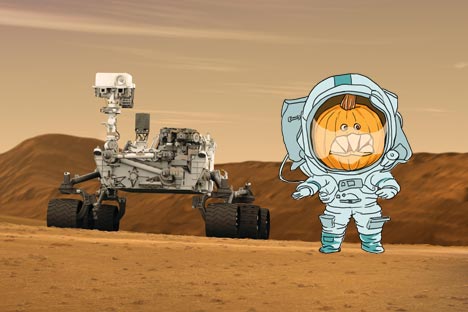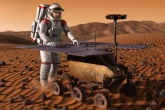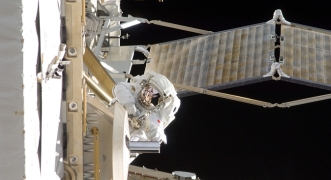Russian device helps NASA search for life on Mars

Russian-made instrument DAN will help Curiosity find life in Mars. Source: NASA / Сollage by Natalya Mikhailenko
Science Magazine has recently run five papers in a single issue to sum up the results of the first year of Curiosity's work on the surface of Mars. The data obtained by the rover's different instruments has helped scientists discover minerals not previously encountered on Mars, as well as assess the quantity and locations of water in the planet's soil.
Curiosity carries a Russian-made instrument known as DAN, which stands for Dynamic Albedo of Neutrons. DAN assesses concentrations of hydrogen in Martian soil by irradiating rock with powerful neutron pulses and measuring the return signals.
Igor Mitrofanov, head of the DAN experiment and laboratory chief at the Space Research Institute of the Russian Academy of Sciences, tells Gazeta.ru what the Russian instrument has found so far and whether there is life on Mars.
Gazeta.ru: Could you please talk about the first results of DAN's operation?
Igor Mitrofanov: This is the first time the neutron sounding method has been employed outside Earth, and the DAN experiment has completely proven our expectations. We have conducted around 200 soil composition measurements along Curiosity's route, obtaining data on the variable content of water and chlorides in Martian soil to a depth of around 60 centimeters [2 feet].
As it turns out, there is relatively little water in the Gale Crater—only 2-3 percent by weight, on average—and most of it lies at depths below 10-20 centimeters. There is even less water closer to the surface — 1-1.5 percent by weight. Chlorine concentrations also vary from one point to another, from 0.7 percent to 1.5 percent by weight. This kind of soil resembles the desert on Earth.
Gazeta.ru: Has DAN justified its developers' expectations?
I.M.: Not only that, it has exceeded them. The service life of the instrument's neutron generator expired in August, but it continues operating normally. We conduct one 15-minute measurement per Martian day on average, while the rover is at rest.
Based on observations from the Martian orbit [made] with the help of another Russian instrument, HEND [part of the Mars Odyssey mission], we had expected the amount of water in the Gale Crater to be much higher — around 5-7 percent by weight.
We may assume that the main portion of subsoil water is located below the 60-centimter depth that DAN sees through to, at a depth of around 1 meter [which is how deep below the surface HEND looks]. This is a fairly interesting conclusion. We are now verifying this theory by correlating data from these two instruments.
Gazeta.ru: Rather than measuring the content of water, DAN gauges concentrations of hydrogen. Can you discern water-related hydrogen from hydrogen contained in minerals?
I.M.: Nuclear physics methods enable us to register the nucleus of an element, but [these methods] provide no clue as to the chemical in which that element is found. This is something that requires methods of analytical chemistry.
Therefore, our methods allow for nothing more than measuring the content of hydrogen. Whether or not it is part of water can be established with the help of other instruments.
I.M.: No, they are not. We may state with certainty that water is the principal hydrogen-containing compound on Mars.
Gazeta.ru: Western press releases concerning Curiosity's operation abound in statements about the discovery of water on Mars. Are these far-fetched projections?
The question is where that water is located, how much of it there is, and what its history is like.
These questions are particularly interesting if we explore the possibility of primitive life forms on Mars by following the logic of "where there is water, there is life."
So far, DAN's data have been supporting our predictions: There is somewhat less water than we expected, but not as little as to change our perception of the planet radically — all the more so as the rover keeps roving and our instrument keeps functioning. Let's wait and see what else we can discover.
First published in Russian in Gazeta.ru.
All rights reserved by Rossiyskaya Gazeta.
Subscribe
to our newsletter!
Get the week's best stories straight to your inbox

